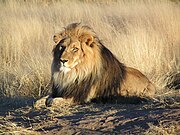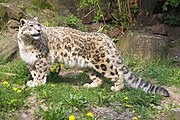Pantherinae
| Pantherinae[1] Temporal range:
| |
|---|---|
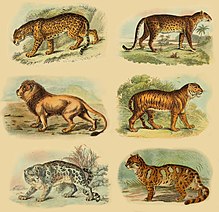
| |
| Pantherinae subfamily members (from left): jaguar, leopard, lion, tiger, snow leopard and clouded leopard | |
| Scientific classification | |
| Domain: | Eukaryota |
| Kingdom: | Animalia |
| Phylum: | Chordata |
| Class: | Mammalia |
| Order: | Carnivora |
| Suborder: | Feliformia |
| Family: | Felidae |
| Subfamily: | Pantherinae Pocock, 1917 |
| Genera | |
| |
The Pantherinae is a
Characteristics
Pantherinae species are characterised by an imperfectly ossified
The
Evolution
The Felidae originated in Central Asia in the Late Miocene; the subfamily Pantherinae diverged from the Felidae between 14.45 to 8.38 million years ago and 16.35 to 7.91 million years ago.[3][4] Several fossil Panthera species were described:
- Panthera blytheae is the oldest known species that possibly lived about 5.95 to 4.1 million years ago.[8]
- Panthera palaeosinensis lived in the early Pleistocene around two to three million years ago in northern East Asia.[9]
- Panthera zdanskyi is dated to 2.55 to 2.16 million years ago.[9]
- Panthera gombaszoegensis lived from about 2 to 0.35 million years ago in Europe.[10]
- Panthera youngi lived in the Pleistocene about 0.69 to 0.42 million years ago in China.[11]
- Cromerian interglacial stage from about 450,000 to 14,000 years ago.[12]
- early Holocene about 340,000 to 11,000 years ago.[13]
- Panthera shawi was a lion-like cat in South Africa that possibly lived in the early Pleistocene.[14]
An additional fossil genus Leontoceryx was described in 1938.[16]
There is evidence of distinct markers for the mitochondrial genome for Felidae.[17][18]
Results of a DNA-based study indicate that the tiger (Panthera tigris) branched off first, followed by the jaguar (P. onca), the lion (P. leo), then the leopard (P. pardus) and snow leopard (P. uncia).[19]
Felis pamiri, formerly referred to as Metailurus, is now considered a probable relative of extant Pantherinae and was moved to the genus Miopanthera.[20]
Taxonomy
Pocock originally defined the Pantherinae as comprising the
Living genera
The following table shows the
| Common name | Scientific name and subspecies | Range | Size and ecology | IUCN status and estimated population |
|---|---|---|---|---|
| Clouded leopard | N. nebulosa (Griffith, 1821) |
Central Nepal to continental Southeast Asia and southern China
|
Size: head to body 68.6–108 cm (27.0–42.5 in) with 61–91 cm (24–36 in) long tail[22] Habitat: Forest and shrubland[23] Diet: Medium-sized and small mammals on the ground and in trees, as well as birds[23] |
VU
|
| Sunda clouded leopard | N. diardi Cuvier, 1823 Two subspecies
|
Parts of Sumatra and Borneo
|
Size: 69–108 cm (27–43 in) long, 61–91 cm (24–36 in) tail[24] Habitat: Forest[25] Diet: Medium-sized and small mammals[25] |
VU
|
| Common name | Scientific name and subspecies | Range | Size and ecology | IUCN status and estimated population |
|---|---|---|---|---|
| Jaguar | P. onca (Linnaeus, 1758) |
Large swathes of South and Latin America, and Arizona in the United States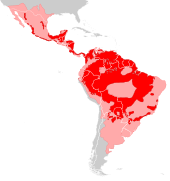
|
Size: 110–170 cm (43–67 in) long, 44–80 cm (17–31 in) tail[26] Habitat: Forest, shrubland, inland wetlands, savanna, and grassland[27] Diet: Variety of mammals, reptiles and birds, preferring ungulates[27] |
NT
|
| Leopard | P. pardus (Linnaeus, 1758) Eight subspecies
|
Much of Sub-Saharan Africa, the Middle East, the Indian subcontinent, the Caucasus in Europe, Southeast Asia, and Siberia
|
Size: 91–191 cm (36–75 in) long, 51–101 cm (20–40 in) tail[28] Habitat: Forest, desert, rocky areas, grassland, savanna, and shrubland[29] Diet: Ungulates, as well as other mammals, insects, reptiles, and birds[29] |
VU
|
| Lion | P. leo (Linnaeus, 1758) Two subspecies |
Sub-Saharan Africa and India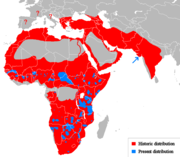
|
Size: 137–250 cm (54–98 in) long, 60–100 cm (24–39 in) tail[30] Habitat: Forest, grassland, shrubland, savanna, and desert[31] Diet: Ungulates such as antelopes, zebra, and wildebeest, as well as other small to large mammals[31] |
VU
|
| Snow leopard | P. uncia (Schreber, 1775) |
Himalayas reaching north to Mongolia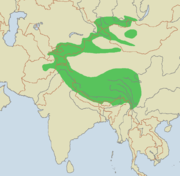
|
Size: 90–120 cm (35–47 in) long, 80–100 cm (31–39 in) tail[32] Habitat: Shrubland, rocky areas, forest, and grassland[33] Diet: Caprids such as sheep and goats, as well as small mammals and birds[33] |
VU
|
| Tiger | P. tigris (Linnaeus, 1758) Two subspecies
|
Scattered sections of Southeast Asia, Indian subcontinent, and Siberia
|
Size: 150–230 cm (59–91 in) long, 90–110 cm (35–43 in) tail[34] Habitat: Shrubland, forest, and grassland[35] Diet: Deer and wild pigs, as well as a wide variety of other animals[35] |
EN
|
See also
References
- OCLC 62265494.
- ^ .
- ^ S2CID 41672825.
- ^ PMID 26518481.
- ^ Hemmer, H. (1966). "Untersuchungen zur Stammesgeschichte der Pantherkatzen (Pantherinae). Teil I" [Researching the phylogenetic history of the Pantherinae. Part I]. Veröffentlichungen der Zoologischen Staatssammlung München. 11: 1–121.
- PMID 2606766.
- PMID 12363272.
- PMID 24225466.
- ^ PMID 22016768.
- .
- PMID 24382145.
- PMID 15012963.
- S2CID 85975640.
- ^ Sabol, M. (2011). "Masters of the lost world: a hypothetical look at the temporal and spatial distribution of lion-like felids". Quaternaire. Hors-série. 4: 229–236.
- S2CID 92328512.
- ^ Kretzoi, M. (1938). "Die Raubtiere von Gombaszo ̈g nebst einer Ubersicht der Gesamtfauna". Annales Musei Nationalis Hungarici. 3.
- S2CID 22736941.
- PMID 15522797. Archived from the original(PDF) on 2011-07-07.
- PMID 15804417.
- S2CID 207195894.
- ^ a b Kitchener, A. C.; Breitenmoser-Würsten, C.; Eizirik, E.; Gentry, A.; Werdelin, L.; Wilting, A.; Yamaguchi, N.; Abramov, A. V.; Christiansen, P.; Driscoll, C.; Duckworth, J. W.; Johnson, W.; Luo, S.-J.; Meijaard, E.; O’Donoghue, P.; Sanderson, J.; Seymour, K.; Bruford, M.; Groves, C.; Hoffmann, M.; Nowell, K.; Timmons, Z.; Tobe, S. (2017). "A revised taxonomy of the Felidae: The final report of the Cat Classification Task Force of the IUCN Cat Specialist Group" (PDF). Cat News (Special Issue 11): 64−75.
- ISBN 978-0-226-77999-7.
- ^ .
- ^ "CatSG: Sunda clouded leopard". International Union for Conservation of Nature Cat Specialist Group. Archived from the original on July 25, 2018. Retrieved March 25, 2019.
- ^ .
- ^ "CatSG: Jaguar". International Union for Conservation of Nature Cat Specialist Group. Archived from the original on March 7, 2015. Retrieved March 25, 2019.
- ^ .
- ^ "CatSG: Leopard". International Union for Conservation of Nature Cat Specialist Group. Archived from the original on June 23, 2018. Retrieved March 25, 2019.
- ^ .
- ^ "CatSG: African lion". International Union for Conservation of Nature Cat Specialist Group. Archived from the original on December 11, 2014. Retrieved March 25, 2019.
- ^ .
- ^ "CatSG: Snow leopard". International Union for Conservation of Nature Cat Specialist Group. Archived from the original on March 18, 2018. Retrieved March 25, 2019.
- ^ .
- ^ "CatSG: Tiger". International Union for Conservation of Nature Cat Specialist Group. Archived from the original on November 12, 2014. Retrieved March 25, 2019.
- ^ .
External links
- Choi, C. Q. (2011). "World's Oldest Tiger Species Discovered". Live Science. Retrieved 2019-06-30.





